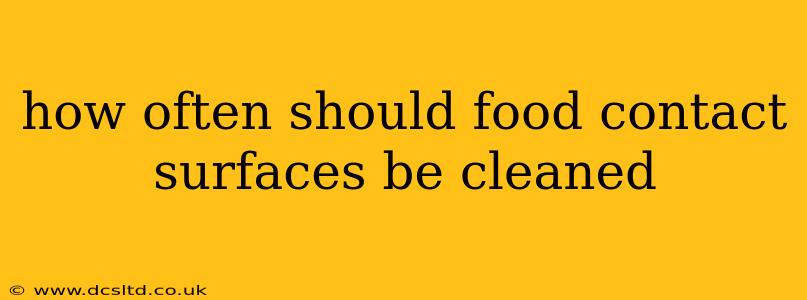Maintaining the cleanliness of food contact surfaces is paramount to preventing foodborne illnesses and ensuring food safety. The frequency of cleaning depends on several factors, but a proactive approach is crucial. This guide will delve into the best practices and answer common questions surrounding the cleaning of food contact surfaces.
What are Food Contact Surfaces?
Before we discuss cleaning frequency, it's important to define what constitutes a food contact surface. These are any surfaces that come into direct contact with food during preparation, processing, packaging, or serving. This includes, but isn't limited to:
- Utensils: Knives, cutting boards, spoons, forks, spatulas.
- Equipment: Food processors, mixers, blenders, slicers, ovens, grills.
- Containers: Plates, bowls, cups, storage containers.
- Work surfaces: Countertops, tables, sinks.
How Often Should Food Contact Surfaces Be Cleaned? A General Guideline
There's no single magic number for how often to clean food contact surfaces. However, a good rule of thumb is to clean and sanitize them after each use. This ensures that any potential contaminants from previous food preparation are removed before the next use. Think of it this way: if you’re cutting raw chicken, you need to thoroughly clean and sanitize the cutting board before using it to chop vegetables.
What About Between Uses Throughout a Single Preparation?
Even during a single preparation process involving multiple ingredients, you should aim for frequent cleaning. If you're preparing a complex recipe with multiple steps, it's best practice to clean and sanitize your surfaces after each step involving raw meat, poultry, seafood, or eggs.
This prevents cross-contamination, where harmful bacteria from one food item contaminate another, potentially leading to foodborne illness.
What's the Difference Between Cleaning and Sanitizing?
Cleaning and sanitizing are two distinct processes, both crucial for food safety:
- Cleaning: This involves removing visible dirt, food particles, and other debris from the surface. Use warm, soapy water and a clean cloth or sponge.
- Sanitizing: This involves reducing the number of harmful microorganisms on the surface to a safe level. There are various sanitizing methods, including using chlorine bleach solutions, iodine solutions, or heat. Always follow the manufacturer's instructions for the chosen sanitizer.
Cleaning should always precede sanitizing.
How Often Should Food Contact Surfaces Be Cleaned in a Restaurant Setting?
Restaurant settings demand stricter and more frequent cleaning protocols due to higher volumes of food preparation and the potential for faster contamination spread. In a restaurant environment, cleaning and sanitizing is often required after each use and at least every four hours. Additionally, more rigorous deep cleaning procedures should be conducted at the end of each day or shift.
What About Cleaning and Sanitizing in a Home Kitchen?
Home kitchens require similar principles but may not demand the same rigorous hourly cleaning protocols as a restaurant. The key is to prioritize cleaning and sanitizing after handling raw meats and focusing on thorough cleaning after each meal preparation. A weekly deep clean of the kitchen, including appliances and countertops, is also highly recommended.
What Are Some Common Mistakes People Make When Cleaning Food Contact Surfaces?
- Not cleaning thoroughly: Failing to remove all visible food residue can leave behind bacteria.
- Using the same cloth or sponge for multiple surfaces: This can spread bacteria from one surface to another.
- Not allowing enough contact time for sanitizers: Sanitizers need adequate time to work effectively.
- Using inappropriate cleaning solutions: Always use food-safe cleaning and sanitizing agents.
What are the consequences of inadequate cleaning of food contact surfaces?
Neglecting proper cleaning and sanitizing can lead to serious consequences, including:
- Foodborne illnesses: Bacteria, viruses, and parasites can contaminate food, causing illness in those who consume it.
- Spoilage: Improperly cleaned surfaces can accelerate the spoilage of food.
- Reputational damage: For restaurants and food businesses, poor hygiene can severely damage reputation and lead to loss of business.
By following these guidelines and adopting a proactive cleaning approach, you can significantly reduce the risk of foodborne illnesses and maintain the highest standards of food safety. Remember, regular and thorough cleaning is an investment in your health and well-being.
